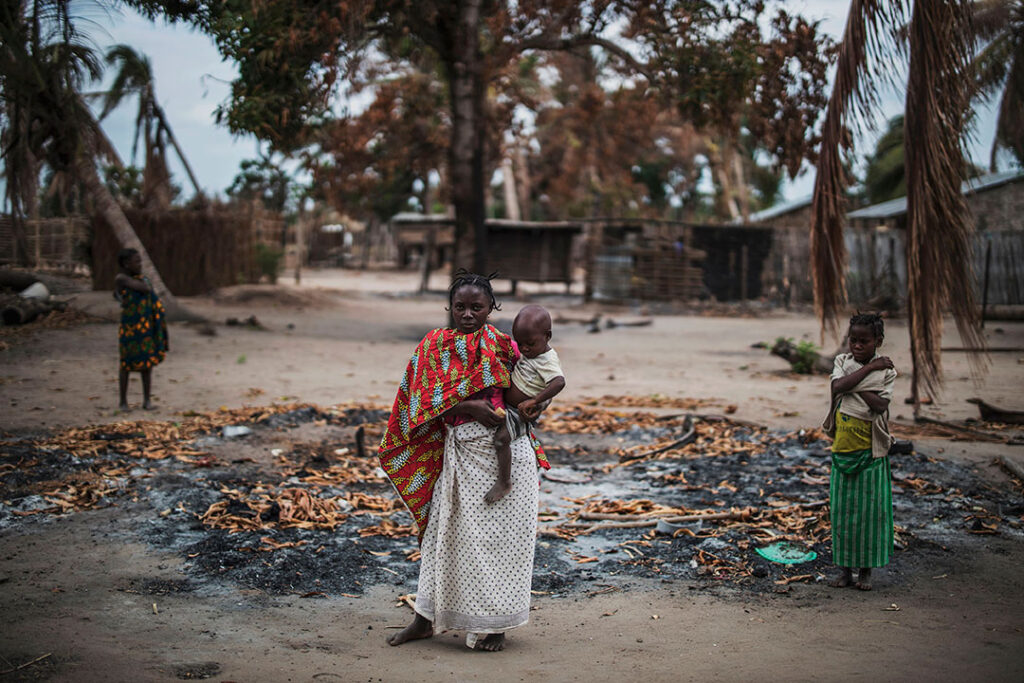ADF STAFF
Terrified residents in Mocimboa da Praia, a small town in Mozambique’s Cabo Delgado province, fled the area in late June amid ongoing clashes between militants and Mozambique’s Defence and Security Forces (FDS).
Many people were missing and several feared dead after the violence settled. Although the FDS regained control of the town, attackers still were nearby.
“It was about 5 in the afternoon when the attackers came and started burning houses. I ran with my wife, and they shot her; they killed her in front of me,” Jaime Momade, a displaced villager, told Al-Jazeera. “I managed to escape. They came with guns and machetes and started burning houses.”
Extremist violence has been increasing in the province, which is rich in underwater gas deposits, where extremist groups have killed more than 1,100 people, including 700 civilians, and displaced more than 200,000 since 2017. Extremists from various groups have attacked security forces, destroyed infrastructure, and stolen weapons and vehicles.
The June attacks left Mocimboa da Praia without electricity, water and phone service. The town likely was chosen because it contains a port, an airfield and a main road leading to the province’s capital, which increases insurgents’ ability to move weapons and export illegal goods.
“The situation is serious; there is a lot of destruction, and it is difficult to know what has not been affected,” a local hotel manager told the Lusa news service.
Although the Islamic State claimed responsibility for attacks in Mocimboa da Praia in March, it was unclear which extremist group was responsible for the latest violence. The extremist group al-Shabaab, insurgents from Kenya and Tanzania, as well as a local group called Ahlu Sunna Wal Jama, all have stormed the region. It is unclear whether the groups are connected, but their penchant for bloodshed is unquestioned, as they are known to kidnap and behead victims.
Ahlu Sunna Wal Jama’s connections with ISIS may be growing tighter, according to a report published July 6, 2020, by data analytics company Babel Street.
The terror group’s recent tactics suggest a growing relationship with ISIS and other extremists, Defense One reported. The Babel Street report said the tactics include “launching small drones for position scouting, displaying Islamic State flags during attacks, beheading victims, and kidnapping girls in the model of Nigeria’s Boko Haram.”
The deadliest recent attack was in the village of Xitaxi in April, when 52 young people were massacred because they refused to join a group of insurgents that had attacked civilians and military targets. FDS spokesman Orlando Mudumane said the young people were killed “cruelly and diabolically.”
“The FDS has been intensifying operations against the insurgents, with a view to neutralizing them and holding them accountable for the heinous criminal acts they have perpetrated in that part of the country,” Mudumane said in a story on clubofmozambique.com. It was unclear to which group the insurgents belonged.
Because Mozambique shares borders with six other nations — Eswatini, Malawi, South Africa, Tanzania, Zambia and Zimbabwe — there are concerns the violence could spread throughout the region. There have been calls for the Southern African Development Community (SADC) to respond to the terrorism, but that has not happened. SADC’s goal is to advance socioeconomic, political and security cooperation among its 16 member nations.
Mozambican President Filipe Jacinto Nyusi has requested aid from his African counterparts, but his pleas have mostly been met with silence. Only Tanzania responded to Nyusi’s call for help, sending troops to the countries’ shared border to boost security.
Some say regional leaders could turn to West Africa for guidance in formulating a response to the terrorists. In the Sahel region, military forces from Burkina Faso, Chad, Mali, Mauritania and Niger have banded together — along with more than 5,000 French troops — under one command to fight terrorism and organized crime.

